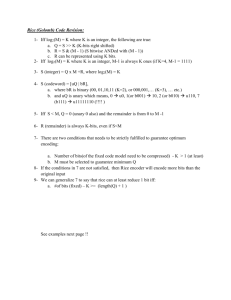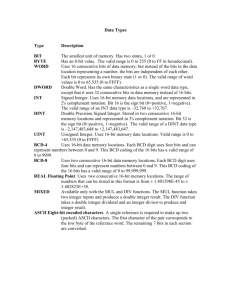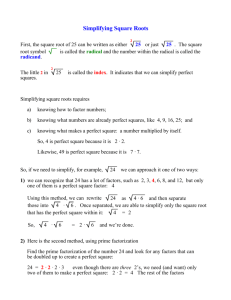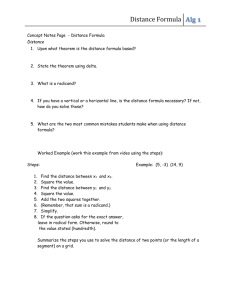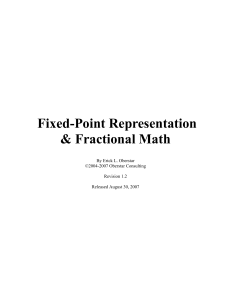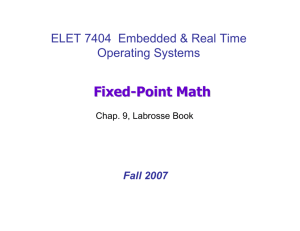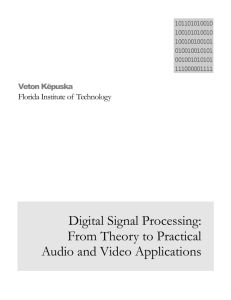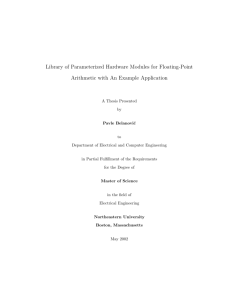Fixed-Point Square Root Algorithm: Technical Report
advertisement
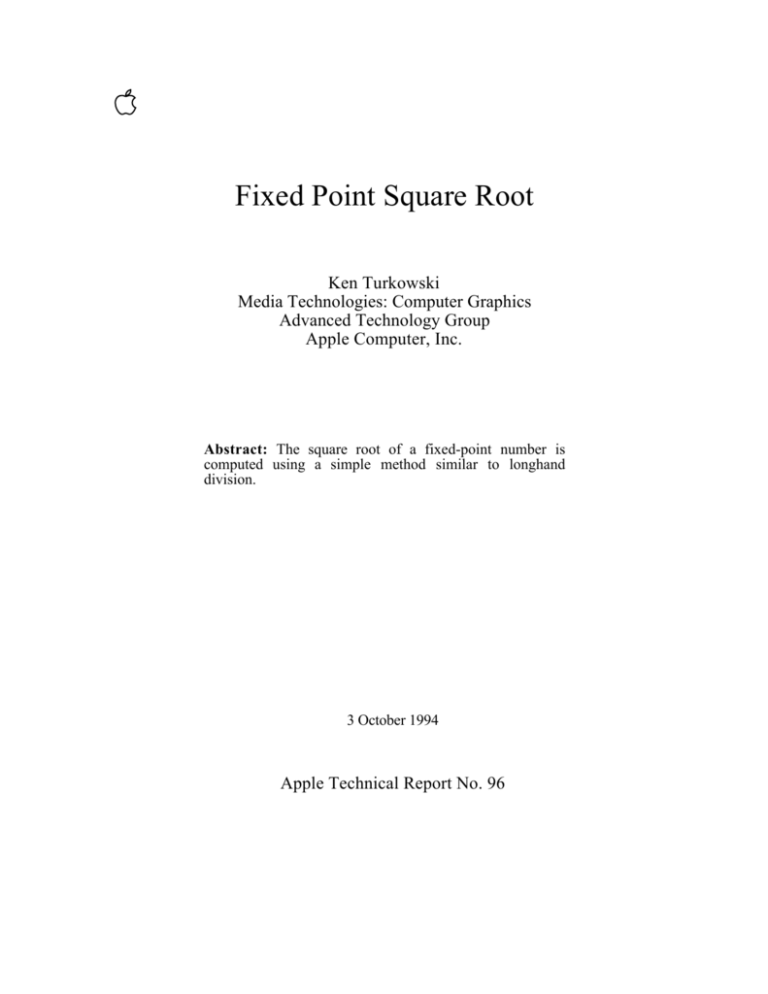
Fixed Point Square Root
Ken Turkowski
Media Technologies: Computer Graphics
Advanced Technology Group
Apple Computer, Inc.
Abstract: The square root of a fixed-point number is
computed using a simple method similar to longhand
division.
3 October 1994
Apple Technical Report No. 96
Turkowski
Fixed Point Square Root
3 October 1994
Fixed Point Square Root
Ken Turkowski
3 October 1994
Introduction
Many graphics algorithms rely upon fixed-point arithmetic and its inherent speed advantage
over floating-point. Often, a fixed-point algorithm requires the evaluation of a square root.
This gem describes an algorithm which computes the square root directly in its fixed-point
representation, saving the expense of (re)converting and evaluating in floating-point. A
related gem [Musial91] computes an approximate integer square root through the use of
integer divisions, but the following algorithm uses more elementary operations.
The Algorithm
The algorithm is based upon a fixed point format having two integer and thirty fractional
bits, using conventional machine (integer) arithmetic instructions. This choice gives a
domain of representation [-2.0, 2.0) suitable for representing normals, colors, and other
graphic quantities whose magnitude is bounded by unity.
This algorithm is based upon a method, similar to long-hand decimal division, that was
taught in schools before the advent of electronic calculators [Gellert75]. This implementation,
called the “binary restoring square root extraction”, substitutes binary digits (bits), further
streamlining the algorithm.
A radical r (the square root of the radicand x) is constructed a bit at a time such that r 2 ≤ x
is always preserved by application of the identity
(r + 1)2 = r2 + 2r + 1
in which the (2r + 1) term is subtracted from the radicand x at each step. If the result is
non-negative, a “1” is generated; otherwise a “0” is generated and the radicand is unaltered
(i.e. restored).
Two radicand bits of are consumed and one radical bit in the radical is generated in each
iteration of the loop. Although this algorithm has only O(n) (linear) convergence, the loop
is so simple that it executes quickly, making it amenable to hardware implementation.
C Implementation
typedef long TFract; /* 2 integer bits, 30 fractional bits */
TFract
FFracSqrt(TFract x)
{
register unsigned long root, remHi, remLo, testDiv, count;
root = 0;
remHi = 0;
remLo = x;
count = 30;
Apple Computer, Inc.
/*
/*
/*
/*
Clear root */
Clear high part of partial remainder */
Get argument into low part of partial remainder */
Load loop counter */
Media Technologies: Computer Graphics
Page 1
Turkowski
Fixed Point Square Root
3 October 1994
do {
remHi = (remHi<<2) | (remLo>>30); remLo <<= 2; /* get 2 bits of arg */
root <<= 1; /* Get ready for the next bit in the root */
testDiv = (root << 1) + 1;
/* Test radical */
if (remHi >= testDiv) {
remHi -= testDiv;
root++;
}
} while (count-- != 0);
return(root);
}
Discussion
A non-restoring version of the algorithm
slightly more complicated inner loop.
[Hwang79]
may run faster at the expense of a
This algorithm may be modified to return the square root of a 32-bit integer by setting
FRACBITS as zero, producing a variant with count=15. Other formats having an even
numbers of fractional bits can be accommodated simply by adjusting these values. Note
that the square root of a long int (thirty-two bits) is a short int (sixteen bits).
References
Gellert75
Hwang79
Musial91
W. Gellert, H. Küstner, M. Hellwich, H. Kästner, The VNR Concise
Encyclopedia of Mathematics, Van Nostrand Reinhold, 1975, pp. 52-53.
Kai Hwang, Computer Arithmetic: Principles, Architecture, and Design,
Wiley, 1979, pp. 360-379.
Christopher Musial, An Integer Square Root Algorithm, In James Arvo,
editor, Graphics Gems II, Academic Press, 1991, pp. 387-388.
Apple Computer, Inc.
Media Technologies: Computer Graphics
Page 2
